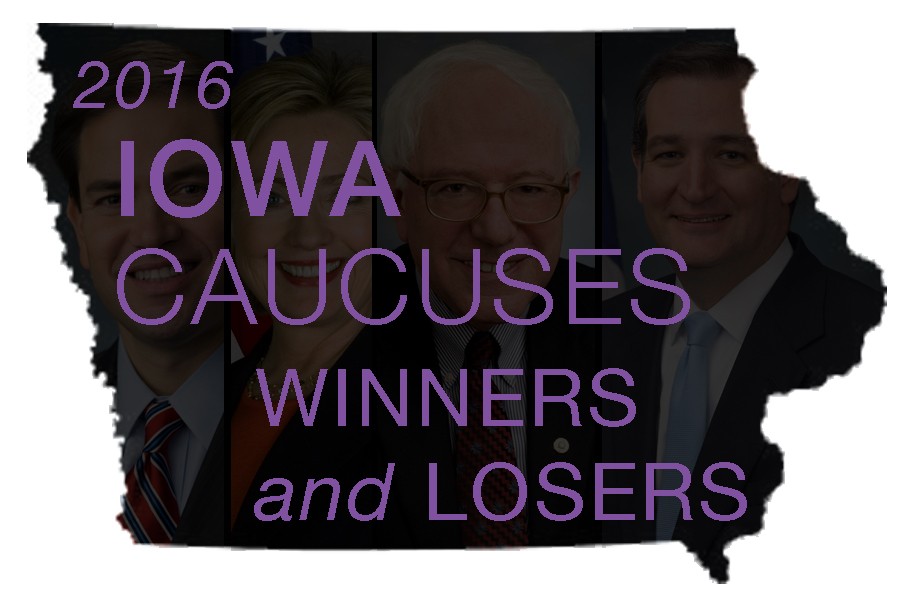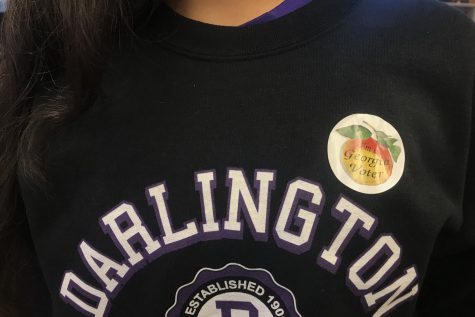Election 2016 – Iowa: Winners and Losers
To the chagrin of Trump Train riders everywhere, Texas Senator Ted Cruz pulled out a strong, first-place victory in the Republican Iowa Caucus on Monday, Feb. 1. Also, on the Democratic side, former Secretary of State Hillary Clinton received a narrow margin of victory over self-proclaimed democratic socialist and Vermont Senator Bernie Sanders. But what does all this mean? Follow along below to find out.
Each presidential election cycle, the two major parties, Democratic and Republican, host caucuses and primaries in all 50 states, Washington DC and the “Minor Outlying Territories” to determine the Parties’ nominees for President of the United States. In a primary, voters cast secret ballots, a method that does not disclose one voter’s allegiance publicly, much like the general election in November. In a caucus, party members show up and visibly support their candidate of choice. This support includes physically moving across a room to clump together with like-minded supporters or raising hands to vote. All-in-all, voters at a caucus operate more openly than a primary.
Due to its stature as first in the nation, the Iowa Caucus elicits much monetary attention from the candidates as they try to gain momentum. Naturally, this swarm of politics and other related drama produces a months-long media circus as commentators and pundits speculate who will emerge top-dog.
However, while Iowa’s influence as the starter gun for Election Season 2016 has yet to be proven, there are several things to take away from this event:
#1.WINNER -> BERNIE SANDERS, LOSER -> HILLARY CLINTON. Even though Hillary Clinton technically won the Iowa Caucus, Clinton’s blatant unpopularity showed.
While frontrunner Hillary Clinton holds a comfortable lead nationally, by about 12-20 points give or take, she has received a surprisingly successful challenge from her left with Bernie Sanders. Sanders, a self-avowed democratic socialist popular with young, college-aged voters, touts his distance from political corruption with his SuperPAC-less campaign. (A SuperPAC is an organization not working directly with a candidate, where big corporations can give unlimited money to a campaign.) Meanwhile, Hillary Clinton receives literally millions of dollars from big banks and huge corporations, like Walt Disney Co. and DreamWorks.
While Sanders enjoys high marks on trustworthiness and honesty, Clinton struggles to break 50 percent in most polls. Mired in controversies concerning both her use of a private server for the storage of government emails and questions about her involvement in the clarity, or lack thereof, of the Benghazi attacks on the American Embassy in Libya on Sept. 11, 2012, Clinton’s political pedigree harms her just as much as it could help.
On the flip side, Sanders has received little to no press on any corruption (aside from a brief server-hacking controversy himself in December 2015). So, Clinton, a candidate who many commentators and analysts have anointed the “presumptive nominee” for the Democratic Party since her announcement to run in April 2015, suddenly has found herself winning Iowa by less than one half of one percent over Bernie Sanders. Clinton: 49.9 percent, Sanders: 49.6 percent.
These margins show that Bernie Sanders, a candidate who seeks to “redistribute money back to the working families of this country” with an over-50-percent tax on the top bracket, can pose a serious threat to the foolproof, embattled Hillary Clinton, at least in the early states of Iowa and New Hampshire, where he leads the polls.
Wow. How far left have these voters strayed?
#2. WINNER -> TED CRUZ, LOSER -> DONALD TRUMP. Ted Cruz’ “tortoise and the hare” strategy could pay off big for his endgame.
The first of any candidate, Republican or Democrat, to announce his or her candidacy, Ted Cruz launched his presidential bid on March 23, 2015. While he received strong support preliminarily, by August, Cruz eventually leveled out to Tier II of the Republican field of 17.
After the Summer 2015 Trump Feeding Frenzy, Cruz enjoyed modest growth in the polls, mainly due to his debate performances, while other candidates, like Ben Carson, Jeb Bush and Scott Walker, spiked, choked, then crashed (the latter of which suspended his campaign even before October).
By December, Cruz polled second in Iowa and nationally. Around that time, Trump began his cookie-cutter hooks and jabs, noting Cruz’ Canadian birth. Towards the end of January, Cruz polled second, barely, to Trump in Iowa. On election night, Cruz pulled out a four-percentage-point victory over Trump.
So what is this victory? More than just a fluke as some “Trumpeters” would want you to believe. In reality, Cruz, with his well organized campaign bureaucracy, amassed a large group of fervent, grassroots supporters to upend the Trump Machine. Cruz stayed on message, took the high road on most attacks (mainly from Trump, of course, who else?) and these tactics rewarded Cruz with his Iowa victory in the end.
With this sort of mobilization, Cruz positions himself as a serious hurdle for Trump to overcome. Trump’s “silent majority” (a term first popularized by Richard Nixon in his 1968 campaign) needs to make a little noise now.
SIDE NOTE: “Because I was told I could not do well in Iowa, I spent very little there – a fraction of Cruz & Rubio. Came in a strong second. Great honor” – Actual tweet from Donald Trump the morning after his loss in Iowa. This tweet might as well say, “I didn’t place much value on Iowa before the race, and it’s not really a big deal after. And, I was just following what someone told me to do so I can’t be blamed for my ‘strong second’ place rank.”
#3. WINNER -> MARCO RUBIO. With a modest rise to the top tier of the Republican pack, many voters are asking, “President Rubio?”
With a “slow and steady wins the race” approach much like the campaign of his Latino Senate comrade Ted Cruz, Florida Senator Marco Rubio managed to place third in Iowa, only short about 2000 votes of defeating Trump. Rubio soared to the spotlight Monday night, riding what many pundits are noting as a “spike at the right time”. Rubio is another candidate to watch; his popular rhetoric in the debates makes him an appealing choice to many voters, as well. Plus, going into the South Carolina primary on Feb. 20, Rubio has now garnered the support of popular South Carolina Senator Tim Scott, which could bolster his polling in another early-voting state.
#4. LOSERS -> THE LIGHTWEIGHTS. Because no one really expected much out of them anyway.
There is a little bloc of totally irrelevant, unviable candidates taking up podium and ballot space including: Republicans Jeb Bush, Ben Carson, Chris Christie, Carly Fiorina, Jim Gilmore and John Kasich. Republicans Mike Huckabee, Rand Paul and Rick Santorum and Democrat Martin O’Malley suspended their bids for president during or soon after the Iowa Caucuses.
These aforementioned candidates all polled at less than nine percent of the vote in Iowa: a worse-than-useless result considering third-placed Marco Rubio polled 23 percent and Carson polled the highest of the lightweights: nine percent.
Jim Gilmore, former Governor of Virginia from 1998-2002 and former Republican National Committee Chair in 2001, received a meager 12 votes out of about 180,000 Republican voters. That’s 0.006 percent, or slightly more than one half of one half of one percent. Even the “Other Candidate” option, with 119 votes, earned more support than Gilmore. Why are Gilmore and his other lightweight friends even running? They have zero support.
Overall, the 2016 Iowa Caucuses proved more fruitful for some candidates than others.












